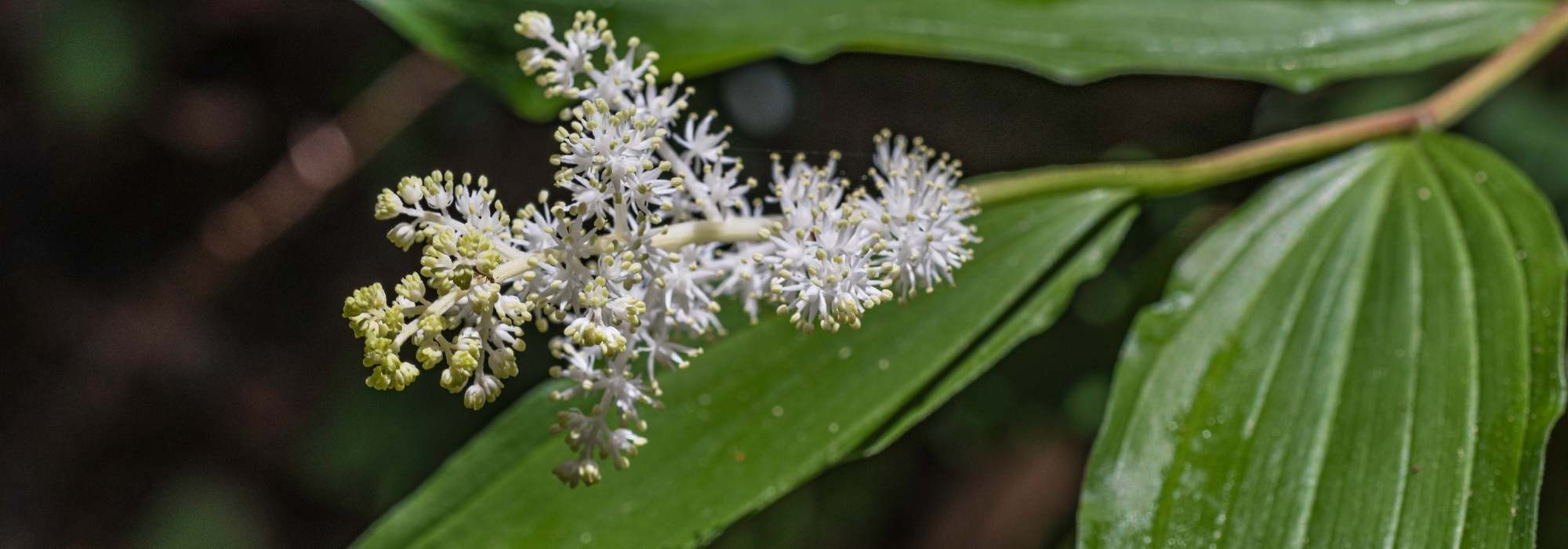
Smilacina: planting and care
Contents
Smilacina in a nutshell
- It is an excellent young plant for woodland areas that enjoys coolness and partial shade
- It offers a beautifully arching white flowering in spring
- It captivates with its generous foliage and graceful silhouette
- It spreads as groundcover in shade or partial shade in cool soils
- Low maintenance and very hardy, it is very easy to grow
A word from our expert
The Smilacina racemosa (syn. Maianthemum racemosa), also known as “False Solomon’s Seal”, is a perennial plant that forms a lush, low-maintenance groundcover. Like its cousin, the Solomon’s Seal (Polygonatum), it spreads in clumps of dense, elegant foliage topped in spring by fluffy spikes of white flowers on beautiful arching stems.
Low-maintenance and very hardy, it is perfect for dressing a cool, natural corner, in woodland or at the base of trees, where it is not afraid of roots.
It thrives in humus-bearing, well-drained, cool soils and prefers a sheltered position from scorching sun.
Discover this beautiful woodland plant with an elegant, natural style and our collection of shade-loving perennials!
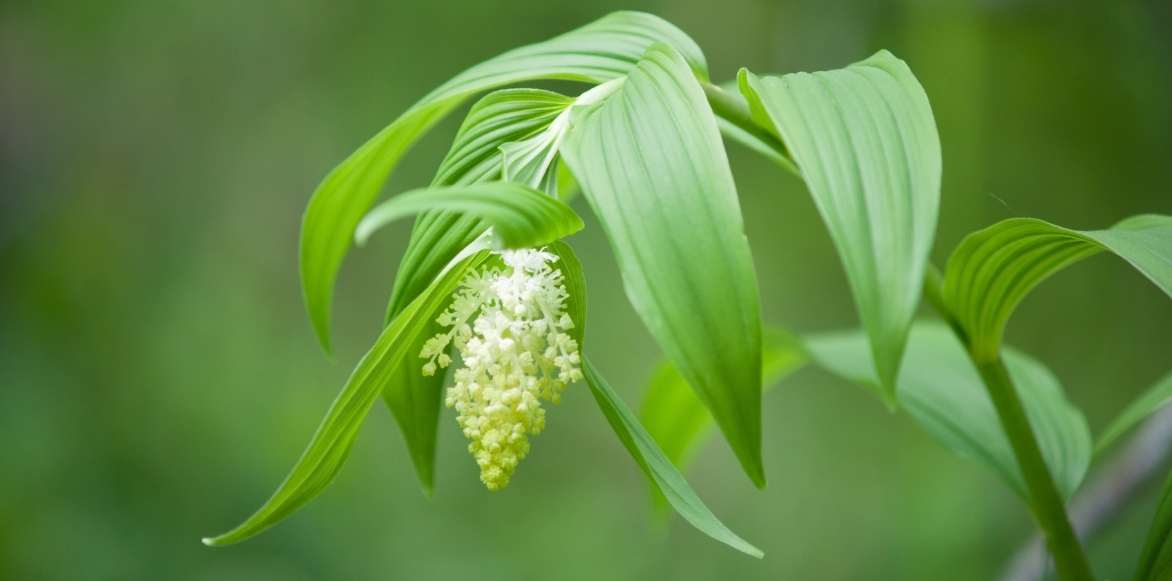
Smilacina racemosa: purity and elegance in woodland
Description and botany
Botanical data
- Latin name Smilacina
- Family Convallariaceae
- Common name May lily, False Lily of the valley
- Flowering May to June
- Height 50 to 80 cm
- Exposure Partial shade
- Soil type Rich, moist, well-drained
- Hardiness -15 °C and beyond
The Smilacina racemosa (synonym Maianthemum racemosa), also known as “False Solomon’s Seal”, is a perennial plant from the botanical family of the lily family. It is sometimes classified today under the Ruscaceae family. It is also found under the name Convallaria racemosa due to its resemblance to Convallaria majalis, more commonly known as Lily of the Valley.
This typical understorey plant grows naturally in humid, shaded wooded areas and alpine meadows up to 2000m in altitude, across much of North America and Canada.
The genus comprises 25 species of rhizomatous perennials, with Smilacina racemosa being the most commonly cultivated. It has a few cultivars that are not numerous. It is well adapted to our climate and possesses excellent hardiness.
Like its cousin Solomon’s Seal (Polygonatum), it spreads as a groundcover reaching about 50 to 90 cm in height, with a minimum spread of 50 cm, thanks to its rhizomes. A bit slow to establish, once well in place, it naturalises easily, eventually forming a lush groundcover without becoming invasive.
In spring, from this rhizomatous base emerges a deciduous foliage that closely resembles that of Solomon’s Seal. The Smilacina racemosa forms clumps of upright, leafy stems that become gracefully arching. The leaves, measuring 12 to 15 cm long, are arranged in two opposite ranks along the stems. They have a basal funnel shape, and the lamina is directly attached to the stem, without a petiole. They are entire, ovate to elliptical, pointed, and marked with strongly defined parallel veins. Glossy, they are bright green, sometimes variegated, like the cultivar ‘Variegata’. In autumn, the foliage takes on a beautiful yellow hue before falling.
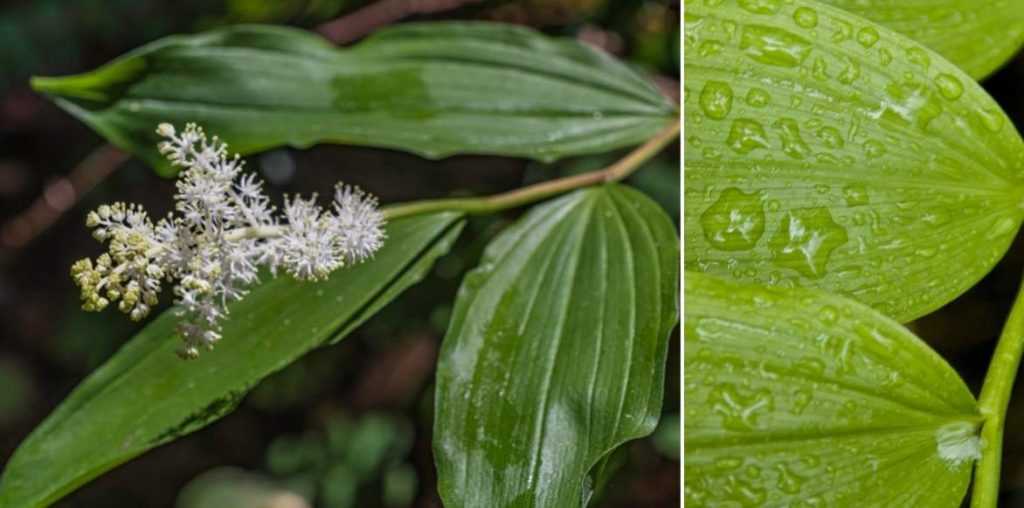
A superb veined foliage
Flowering occurs in spring and early summer, in May and June. With its airy appearance, it resembles that of the Salsepareille, in Latin Smilax aspera, which has given the plant its name Smilacina. Delicate, light, yet abundant, it appears at the tips of the stems. It consists of numerous small flowers with 6 petals, measuring 3 to 6 mm wide, gathered in dense, branched panicles 10 to 15 cm high, which bloom above the foliage. They are white to cream, sometimes tinged with green. The plant somewhat resembles a giant lily of the valley.
Once pollinated, these delicate spikes, remarkable for their freshness, transform into small edible fleshy berries, round, quite decorative, initially green, turning dark purple-red at maturity. Its fruits are not toxic like those of lily of the valley or Solomon’s Seal.
Although it is not cultivated in our gardens for culinary purposes, it is worth noting that almost the entire plant is edible: the rhizomes can be consumed cooked, its young shoots can be enjoyed like asparagus, which they resemble in flavour, and the small fruits rich in vitamin C reveal a slightly bittersweet taste.
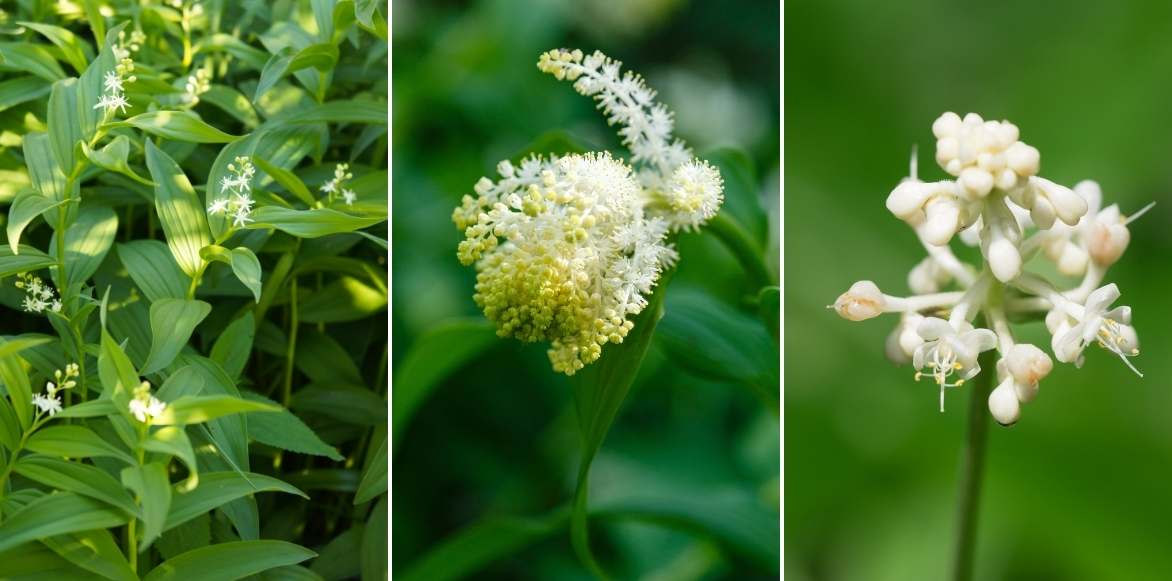
Smilacina stellata, Smilacina racemosa and Smilacina japonica
Read also
The best hardy geraniums for shadeMain species
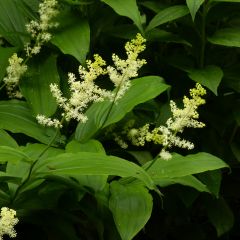
Smilacina racemosum
- Flowering time June, July
- Height at maturity 80 cm
Discover other Smilacina
View all →Available in 1 sizes
Available in 1 sizes
Available in 1 sizes
Available in 1 sizes
Planting
Where to plant?
A true woodland plant, perfectly hardy below -15°C, Smilacina thrives in all regions, although it may struggle in the too-dry Mediterranean climate as it requires constant moisture at its base to prosper. You can place it at the foot of trees and bushes, as it does not fear root competition. It enjoys cool conditions and grows in shade or partial shade. Its preference is for sunny but filtered, non-burning exposures.
It grows well in any light, neutral to acidic soil that remains cool and humus-bearing but well-drained. However, once established, it will adapt very well to dry shade under the cover of trees and shrubs.
Smilacina racemosa is perfect for bringing brightness to the edge of clear woodland, where the soil remains consistently cool, or for quickly colonising shrub beds or riverbanks. It makes an excellent groundcover in neglected areas of the garden, where few plants are willing to grow.
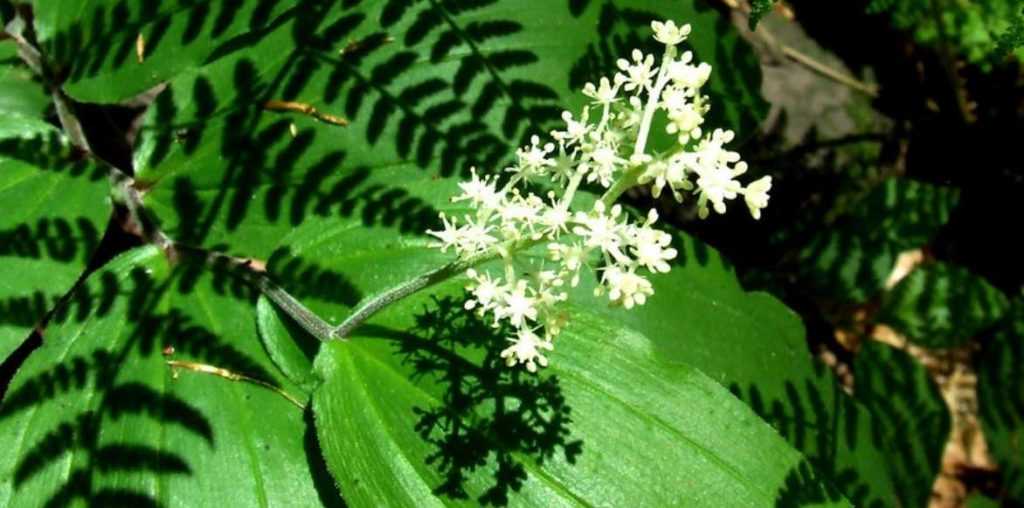
Smilacina racemosa (© Dave Bonta)
When to plant?
Plant in spring (March-April) or autumn (September-November), avoiding frost periods.
How to plant?
In open ground, to achieve a dense groundcover, plant 5 young plants per m² spaced 50 to 60 cm apart. Smilacina racemosa flourishes more in rich, humus-rich soil.
- Dig a hole 2 to 3 times the size of the root ball
- Loosen the soil well
- Add a good shovelful of compost
- Plant your Smilacina, ensuring the collar is level with the soil
- Fill in with a mix of potting soil, garden soil, and compost
- Firm the soil
- Water generously and regularly until established
- You may apply an organic mulch made of fallen leaves, for example
Maintenance and care
If it is a bit slow to establish, once well-rooted, Smilacina requires little attention. The soil should remain sufficiently cool throughout the summer, especially in the first few years following planting. In summer, during the first year, water regularly, approximately every 5 days. Mulch the clump from spring with a layer of turf, for example, to keep the roots cool during summer and reduce the need for watering.
As it is very hardy, it does not need protection from the cold in winter.
It prefers humus-rich soils: every year at the beginning of spring, incorporate a good layer of well-decomposed compost or a little ground horn by lightly scratching the surface.
At the end of autumn, you can cut the clump back to ground level.
Smilacina is rarely affected by diseases. However, be cautious of slugs and snails in spring. To protect your plants from their appetite, you can discover our natural solutions.
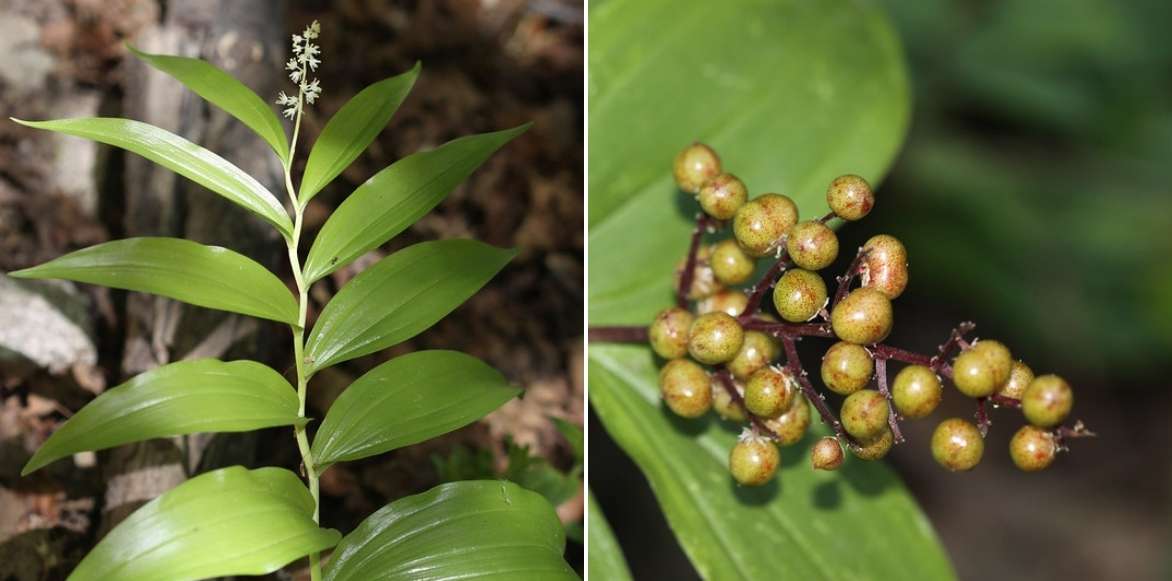
Smilacina racemosa: plant and fruits (© Andrey Zharkikh)
Multiplication of Smilacina racemosa
Dividing rootstocks every 4-5 years to ensure the longevity of the plant is a good method when they start to age.
- Using a fork, lift part of the clump by levering it up
- Cut a rootstock with a sharp, clean knife
- It should have at least one bud
- Replant immediately in open ground in a mix of sand and light compost
- Water regularly but not excessively to encourage recovery
Pairing ideas
The stunning Smilacina racemosa is a must-have in shade gardens, whether in borders or woodlands. It is ideal for bringing brightness to all cool and shaded areas of the garden. This beautiful groundcover is very easy to grow in our wild and wooded gardens.
To create a fresh scene, plant Smilacina racemosa alongside other woodland perennials and dry shade perennials such as Omphalodes, hardy geraniums cantabrigiense, or Geranium nodosum, Epimediums, or Elf Flowers, along with its cousin, lily of the valley. It pairs easily under trees with the decorative foliage of Heuchera, Heucherellas, and Tiarellas. At the edge of a cool woodland, it is perfect with its shade companions such as ferns, ligularias, and silver candles.
In a slightly wild woodland, it will easily naturalise alongside small spring bulbs to naturalise, such as muscari, anemones, wood hyacinths, squills, ipheions, and daffodils.
Also consider other groundcover perennials for shade, such as columbines or Asarums with their delicate flowers.
In a shaded border, you can combine it with Solomon’s seal, which is quite similar aesthetically, along with Bleeding hearts, Arums, and Ophiopogons.
At the edge of a pond, it pairs well with Rodgersia.
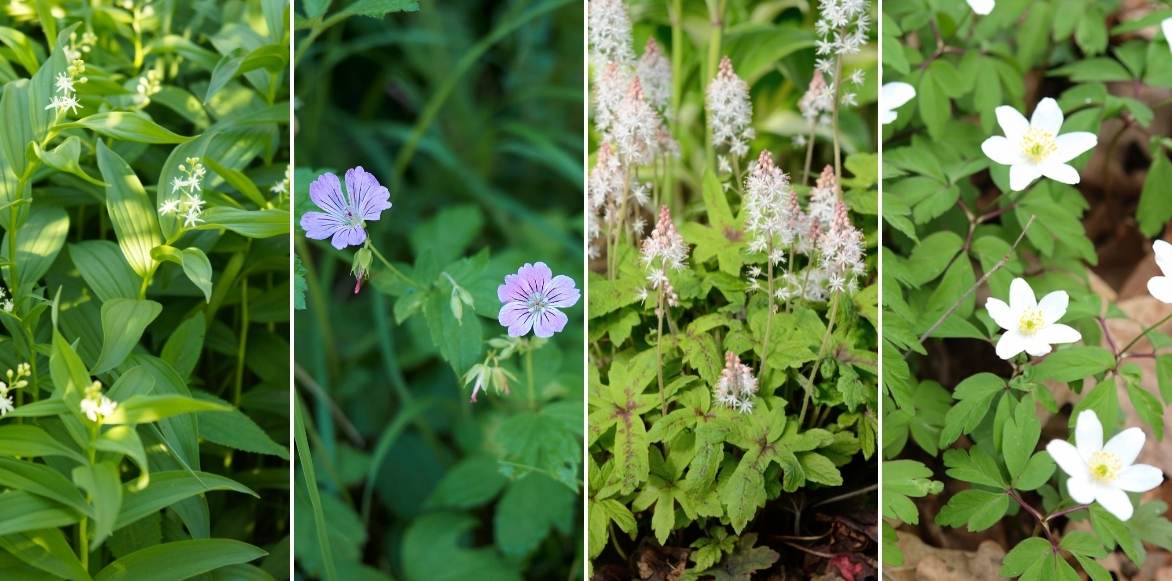
Smilacina racemosa in charming company: Geraniums nodosum, Tiarellas, and wood anemones
Useful resources
- Consider groundcover perennials and try our tried-and-true options!
- Do you have a tricky shaded nook to enhance? Discover our tips, plants, and solutions for a shade garden.
- Do you have an understorey to flower? Get inspired by our articles “What to plant under my trees?” and our suitable solutions and plants.
- Subscribe!
- Contents































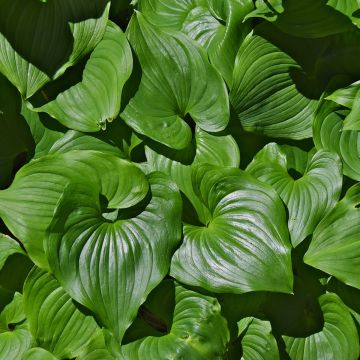

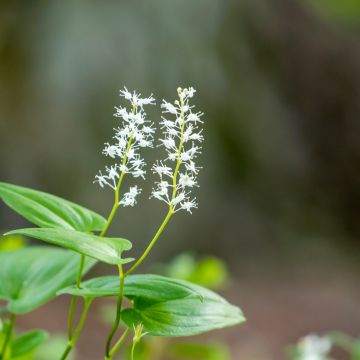
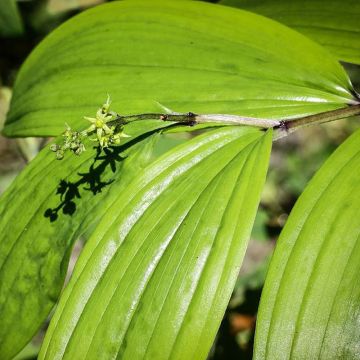
Comments